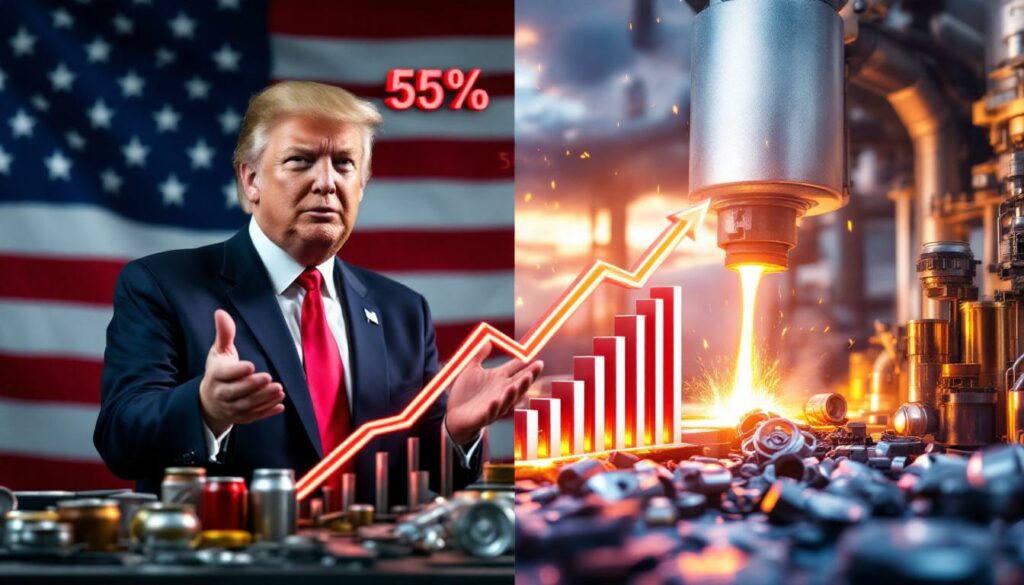Understanding the Financial Impact of US Tariffs on Rio Tinto
In a dramatic development for global aluminum markets, Rio Tinto recently revealed that Trump's aluminum tariffs have cost the company a staggering $321 million in gross costs during the first half of 2025. This figure, disclosed in the company's mid-year production report, represents one of the most significant financial impacts of the administration's evolving trade policies on a single metals producer.
According to Rio Tinto's statement, "a substantial part [of the tariff costs] has been clawed back from higher premiums on US sales," though the company acknowledges that cost recovery remains incomplete following the rapid escalation of tariff rates.
The mining giant shipped approximately 723,000 tons of aluminum to the US market in the first half of 2025, representing roughly three-quarters of its Canadian production. As Canada's largest aluminum producer, Rio Tinto has found itself particularly vulnerable to US tariffs impact on Canadian industries, given its heavy reliance on the American market.
What are the direct costs of aluminum tariffs to Rio Tinto?
The $321 million tariff expense disclosed by Rio Tinto offers a rare glimpse into the actual financial burden these trade policies place on individual companies. While the headline figure is substantial, industry analysts note that Rio Tinto's ability to pass through costs via premium adjustments has softened the impact.
"The premiums rapidly adapted to the initial 25% tariff," according to Rio Tinto's production report, but the company acknowledged that the market hadn't fully adjusted to the 50% tariff by the end of Q2. This lag in premium adjustment created a temporary financial gap that directly impacted Rio Tinto's bottom line.
For context, the company's Canadian smelters, which represent a cornerstone of its aluminum business, depend heavily on US buyers. With three-quarters of this production directed stateside, even small changes in tariff rates create outsized financial consequences.
"The impact of tariffs is still feeding through to inflation and sentiment," Rio Tinto warned in its production report, signaling broader economic concerns beyond its own financial statements.
How have US aluminum premiums responded to tariff changes?
The market's reaction to the aluminum tariffs has been remarkable, though not uniform. Midwest premium contracts, which reflect the additional cost to deliver aluminum to the US Midwest region compared to the London Metal Exchange (LME) price, reached an unprecedented 66 cents per pound by mid-2025—nearly triple the premium level from early 2025.
This premium surge represents the market's attempt to absorb the tariff impact, effectively transferring much of the cost from producers to US consumers of aluminum. However, the adjustment mechanism has shown limits, particularly following the rapid escalation from 25% to 50% tariffs in June 2025.
The premium adjustment process works as follows:
- Initial tariff announcement triggers immediate premium increases
- Market participants negotiate new contract terms reflecting tariff rates
- Spot premiums rise first, followed by term contracts
- Eventually, most of the tariff cost is embedded in the US premium
This process worked efficiently for the initial 25% tariff but struggled to keep pace with the sudden jump to 50%, creating temporary margin pressure for producers like Rio Tinto.
What is the broader context of Trump's trade policies?
The aluminum tariffs represent just one component of an expanding trade policy agenda that has created significant disruption across global metals markets throughout 2025.
How have metals tariffs evolved in 2025?
The administration's metals tariff strategy has followed a clear pattern of escalation:
- March 2025: Implementation of blanket 25% import fees on steel and aluminum
- June 2025: Increase to 50% tariffs on both aluminum and steel imports
- Mid-2025: Announcement of planned 50% tariff on copper, causing what industry observers described as "market mayhem"
- Ongoing: Administration investigations into potential tariffs on other metals
This progression reveals an increasingly aggressive trade stance that has created significant uncertainty for global metals producers, consumers, and investors. The rapid escalation from 25% to 50% tariffs within just three months caught many market participants off-guard, contributing to pricing volatility.
The copper tariff announcement, though not yet implemented at the time of Rio Tinto's report, had already triggered market disruption as buyers and sellers attempted to position themselves ahead of potential implementation. Furthermore, Trump's executive actions have caused additional uncertainty in metals markets.
What are the ripple effects across industries?
The aluminum tariffs have created cascading impacts well beyond the metals production sector.
Beverage industry companies have been particularly vocal about cost increases. Constellation Brands, for example, projected $20 million in additional costs related to the aluminum tariffs. As a major producer of beer and other canned beverages, the company faces direct exposure to aluminum pricing.
Supply chains across multiple industries are adjusting to what Rio Tinto described as "trade tumult." The rapid policy changes have complicated inventory management, pricing strategies, and long-term planning for companies throughout the aluminum value chain.
Industry executives have warned that the tariffs "risk crushing American demand" if costs are fully passed through to end consumers, potentially creating a self-defeating outcome for the policy.
Inflation concerns have amplified as metals price increases feed into consumer goods pricing. Rio Tinto specifically noted that tariffs impact on markets are "still feeding through to inflation and sentiment," suggesting broader economic consequences beyond direct industrial effects.
How is Rio Tinto adapting to the tariff environment?
Facing substantial tariff costs, Rio Tinto has implemented a multi-faceted approach to navigate the challenging trade landscape.
What strategic adjustments is Rio Tinto making?
Premium pricing strategies have become central to Rio Tinto's tariff response. By capitalizing on the significantly higher Midwest premium, the company has recouped "a substantial part" of its tariff costs, though not the entire amount following the most recent escalation to 50%.
The company continues to focus on the US market despite tariff challenges, recognizing that premium pricing in the US often makes it more profitable than alternative markets even after accounting for tariffs. This explains why Rio Tinto maintained its high volume of US shipments (723,000 tons) during H1 2025 despite the tariff burden.
Rio Tinto's response also demonstrates the importance of market segmentation in international trade. By differentiating between geographic markets and their respective pricing structures, the company can optimize its global sales strategy to minimize tariff impacts despite facing Rio Tinto's tax and royalty pressures in various jurisdictions.
Behind the scenes, the company is likely implementing supply chain resilience measures, though specific details weren't disclosed in their production report. These typically include:
- Scenario planning for further tariff increases
- Exploration of alternative markets for partial volume redirection
- Contract structures that allow for premium adjustments as tariffs change
- Dialogue with customers about shared tariff burden
What are the long-term implications for aluminum producers?
The evolving tariff situation creates significant strategic implications for Rio Tinto and other aluminum producers with North American operations.
North American production advantages have paradoxically increased for companies like Rio Tinto with Canadian operations. While Canadian aluminum faces tariffs entering the US, the premium pricing environment often more than compensates, creating stronger margins than producers facing higher production costs elsewhere.
The pricing structure changes in the US aluminum market appear increasingly permanent rather than temporary. With premiums triple their early-2025 levels, a "new normal" may be emerging in how aluminum is priced for US consumption.
Competitive positioning is shifting among global producers. Those with significant Canadian production capacity, like Rio Tinto, maintain stronger positions in the US market compared to producers from other regions facing identical tariff rates but higher base production costs.
How are tariffs affecting the broader metals market?
The aluminum tariffs exist within a complex landscape of evolving trade policies affecting multiple metal commodities simultaneously.
What patterns are emerging across metal commodities?
Aluminum futures have shown significant price divergence between US and international markets. The record Midwest premium of nearly 66 cents per pound has effectively created a two-tier global pricing system, with US consumers paying substantially more than international buyers for the same commodity.
Similar disruptions are occurring in steel markets, which face identical tariff rates to aluminum. The copper market experienced anticipatory disruption following the announcement of planned 50% tariffs, though implementation details remained pending at the time of Rio Tinto's report.
These parallel developments across metal commodities suggest a coordinated approach to metals trade policy rather than aluminum-specific concerns. The administration's investigation into "potential measures on other metals" indicates this pattern may continue expanding.
Regional supply rebalancing is underway as global trade flows adjust to the new tariff environment. While Rio Tinto has maintained its high volume of Canadian exports to the US, other producers lacking the advantage of North American production may be redirecting shipments to alternative markets.
What economic indicators are being affected?
Metals price inflation has become a significant factor in broader inflationary pressures. The tripling of the Midwest aluminum premium represents just one example of how rapidly tariffs can influence commodity pricing.
Manufacturing cost increases for downstream industries have been substantial, as evidenced by Constellation Brands' $20 million projected impact. Aluminum-intensive industries like beverage packaging, automotive manufacturing, and construction face particularly acute cost pressures.
Consumer price impacts are beginning to materialize as companies determine how much of the tariff burden to absorb versus pass through to customers. The aluminum tariff's impact on consumer goods ranges from beverage containers to electronics to vehicles, potentially affecting a broad spectrum of consumer spending.
Market sentiment shifts regarding trade policy uncertainty have created additional volatility as investors and business leaders attempt to anticipate future policy developments. Rio Tinto specifically cited this sentiment impact in its production report, suggesting psychological factors beyond direct costs.
FAQ: Key Questions About Aluminum Tariffs
How do aluminum tariffs affect consumer goods prices?
Aluminum tariffs create a cascading effect through supply chains, eventually reaching consumer products. The impact varies by product category, depending on aluminum content and competitive dynamics:
- Beverage containers: Companies like Constellation Brands face direct exposure, projecting $20 million in additional costs.
- Automotive components: Vehicles contain substantial aluminum, especially in newer fuel-efficient models.
- Construction materials: Windows, doors, and structural components often use aluminum.
- Consumer electronics: Aluminum is widely used in laptops, smartphones, and other devices.
The degree to which these costs are passed to consumers depends on each industry's competitive landscape and price sensitivity. Some companies absorb a portion of the costs to maintain market share, while others pass them through more completely.
Why did the US implement aluminum tariffs?
The aluminum tariffs were implemented as part of a broader trade policy agenda aimed at protecting domestic producers and addressing perceived trade imbalances. Administration officials have cited concerns about maintaining domestic production capacity for national security reasons.
The rapid escalation from 25% to 50% tariffs in just three months suggests strategic objectives beyond simple revenue generation or industrial protection. The inclusion of Canadian aluminum, despite Canada's status as a close ally and trading partner, indicates a comprehensive approach rather than country-specific concerns.
How do Canadian aluminum producers compare to global competitors?
Canadian aluminum production offers several competitive advantages even with tariffs applied:
- Geographic proximity to US markets reduces transportation costs
- Established supply chain relationships with US customers
- Currency advantages when the Canadian dollar trades below the US dollar
- Regulatory stability compared to some alternative producing regions
These factors help explain why Rio Tinto continues directing three-quarters of its Canadian production to the US market despite the tariff burden. The combined advantages often outweigh the tariff costs, particularly when US premiums adjust to reflect much of the tariff impact.
What alternatives do US buyers have to tariffed aluminum?
US buyers face limited alternatives to importing aluminum despite tariffs:
- Domestic production cannot meet total US demand
- Tariff exemption applications are available but involve complex administrative processes
- Product redesign to use less aluminum or alternative materials
- Absorption of higher costs through margin compression or consumer price increases
The record Midwest premium indicates US buyers continue purchasing imported aluminum despite tariffs, suggesting limited viable alternatives in the short term. Domestic capacity constraints make import substitution particularly challenging for aluminum compared to some other tariffed products.
Further Exploration
Readers interested in learning more about the impact of trade policies on global metals markets can explore related educational content about aluminum industry dynamics and international trade policies affecting mining companies.
The ongoing evolution of aluminum premiums provides a real-time case study in how markets adjust to trade policy disruptions. As Rio Tinto and other producers navigate this challenging landscape, the ultimate distribution of tariff costs between producers, consumers, and end users continues to develop.
Future developments worth monitoring include potential expansion of tariffs to additional metals, changes in premium adjustment patterns as markets adapt to the 50% rate, and company-specific strategies for managing tariff impacts through the remainder of 2025 and beyond.
Rio Tinto's upcoming earnings reports will likely provide additional insights into the longer-term financial impact of these tariffs and the company's strategic response as market conditions continue evolving. Additionally, industry observers will be watching closely to see if proposed tariff breaks materialize to provide relief for certain sectors of the mining industry, as reported by Mining Weekly.
Ready to Spot the Next Major Mineral Discovery Before the Market?
Discovery Alert's proprietary Discovery IQ model delivers real-time notifications on significant ASX mineral discoveries, instantly empowering subscribers to identify actionable opportunities ahead of the broader market. Understand why historic discoveries can generate substantial returns by visiting Discovery Alert's dedicated discoveries page.




